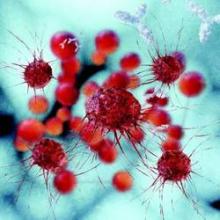Circulating tumor cells (CTCs) individually isolated from blood specimens of men with metastatic prostate cancer showed significant heterogeneity within individual patients, including androgen receptor mutations and multiple mRNA splicing variations, and significantly enriched Wnt signaling in enzalutamide-resistant patients, according to research published in Science.
More than half of the patients had multiple androgen receptor (AR) splice variants within different CTCs, and one in six CTCs simultaneously expressed several AR splice variants.
“The heterogeneity of CTCs in patients with CRPC [castration-resistant prostate cancer] stands in contrast to the striking homogeneity of AR signaling in single CTCs from untreated patients,” wrote Dr. David Miyamoto of the department of radiation oncology, Massachusetts General Hospital, Boston, and his colleagues (Science. 2015 Sept 16 [doi: 10.1126/science.aab0917]).
Researchers established single-cell RNA-sequencing profiles of tumor cells isolated after microfluidic enrichment from blood specimens of men with prostate cancer. Single-cell RNA-sequencing profiles were obtained from 77 CTCs isolated from 13 patients with metastatic prostate cancer, as well as comprehensive transcriptomes of primary prostate cancers from 12 patients.
Using the Pathway Interaction Database, the researchers identified 21 pathways upregulated in CTCs vs. primary tumors. The majority involved growth factor, cell adhesion, and hormone signaling.
Among the CTCs from patients with castration-resistant prostate cancer, 43% expressed at least one AR splice variant (8 of 11 CRPC patients), and 18% expressed more than one splice variant simultaneously (7 of 11 patients).
By contrast, no such alterations were found in the 12 primary prostate tumors analyzed, and one of four CTCs from patients with castration-sensitive prostate cancer that was previously untreated had low-level expression of an AR splice variant.
To evaluate heterogeneity in CTCs that may arise from additional selective pressure exerted by second-line therapies, the researchers retrospectively analyzed cells that were exposed (5 patients, 36 CTCs) or not exposed (8 patients, 41 CTCs) to enzalutamide, a potent AR inhibitor approved by the FDA for CRPC. CTCs from enzalutamide-resistant patients were significantly enriched in Wnt signaling, which mediates cell survival, proliferation, and motility.
Recent studies have shown that glucocorticoid receptor signaling contributes to antiandrogen resistance. Although GR transcripts were not significantly elevated among the enzalutamide exposed vs. nonexposed CTCs, there was an inverse relationship between GR expression and noncanonical Wnt signaling. The two AR-independent resistance pathways appear to predominate in different subsets of cells.
The study indicated that alterations conferring resistance to antiandrogen therapy, whether AR dependent or AR independent, varied considerably among CTCs. These results “point to complex and heterogeneous drug resistance mechanisms in advanced prostate cancer, which may affect therapeutic efficacy,” the authors noted.
Dr. Miyamoto reported having no relevant financial disclosures. Two of his coauthors reported financial ties to industry sources. The Massachusetts General Hospital has filed for patent protection on the CTC-iChip technology.


